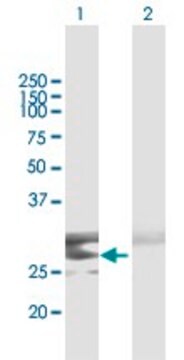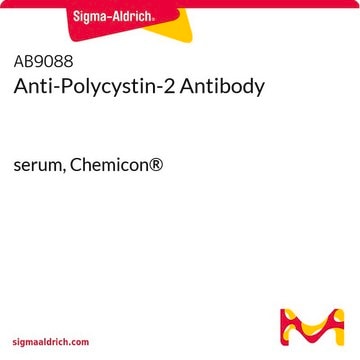ABE2626M
Anti-PASD1
from rabbit
Sinonimo/i:
Circadian clock protein PASD1, Cancer/testis antigen 63, CT63, OX-TES 11, PAS domain-containing protein 1
About This Item
Prodotti consigliati
Origine biologica
rabbit
Livello qualitativo
Forma dell’anticorpo
affinity isolated antibody
Tipo di anticorpo
primary antibodies
Clone
polyclonal
Reattività contro le specie
human
Confezionamento
antibody small pack of 25 μg
tecniche
immunoprecipitation (IP): suitable
western blot: suitable
Isotipo
IgG
N° accesso NCBI
N° accesso UniProt
modifica post-traduzionali bersaglio
unmodified
Informazioni sul gene
human ... PASD1(139135)
Categorie correlate
Descrizione generale
Specificità
Immunogeno
Applicazioni
Epigenetics & Nuclear Function
Immunoprecipitation Analysis: 5 ug from a representative lot immunoprecipitated PASD1 in 500 µg of SW480 lysate.
Western Blotting Analysis: A representative lot detected PASD1 in HEK293T transfected myc-his Tagged PASD1 lysate V2 isoform (Courtesy of Dr Carrie Partch at University of California Santa Cruz).
Immunoprecipitation Analysis: A representative lot detected PASD1 in H1299 & SW480 cells (Courtesy of Dr Carrie Partch at University of California Santa Cruz).
Immunoprecipitation Analysis: A representative lot detected PASD1 in H1299 and SW480 cell lysates (Michael, A.K., et. al. (2015). Mol Cell. 58(5):743-54).
Qualità
Western Blotting Analysis: 0.2 µg/mL of this antibody detected PASD1 in lysate from HEK293T cells transfected myc-His Tagged PASD1, isoform 1, version2.
Descrizione del bersaglio
Stato fisico
Stoccaggio e stabilità
Altre note
Esclusione di responsabilità
Not finding the right product?
Try our Motore di ricerca dei prodotti.
Codice della classe di stoccaggio
12 - Non Combustible Liquids
Classe di pericolosità dell'acqua (WGK)
WGK 1
Certificati d'analisi (COA)
Cerca il Certificati d'analisi (COA) digitando il numero di lotto/batch corrispondente. I numeri di lotto o di batch sono stampati sull'etichetta dei prodotti dopo la parola ‘Lotto’ o ‘Batch’.
Possiedi già questo prodotto?
I documenti relativi ai prodotti acquistati recentemente sono disponibili nell’Archivio dei documenti.
Il team dei nostri ricercatori vanta grande esperienza in tutte le aree della ricerca quali Life Science, scienza dei materiali, sintesi chimica, cromatografia, discipline analitiche, ecc..
Contatta l'Assistenza Tecnica.








